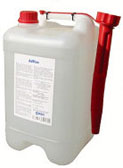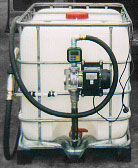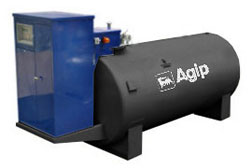What is the AdBlue?
AdBlue is a stable, non-toxic and non-flammable, aqueous solution, which has been developed for follow-up treatment of exhaust gases of heavy-duty diesel powered vehicles and buses, allowed to be put into circulation from the month of October of 2006, meeting Euro IV and Euro V standard.
The liquid is a solution of hihg purity of urea in demineralised water, in which the proportion of urea is around 32,5%. AdBlue is a product which has been made expressly for reducing emission of harmful materials from SCR-equipped vehicles (lorries and buses) (Selective Catalytic Reduction), within these especially emission of oxides of nitrogen. SCR system doses AdBlue fuel additive vaporized in compressed air directly before catalytic converter, to hot exhaust gas outflowing from combustion chamber.
 |
On high temperature amonia is produced from urea. In the second step oxides of nitrogen of exhaust gas react with amonia in the surface of SCR catalytic converter. During this reaction oxides of nitrogen are converted by a chemical reaction into their basic and non-polluting forms, water and nitrogen gas which can be found in nature too in big mass. Advantage of SCR technology is that meets the requirements concerning to oxides of nitrogen emission of both Euro IV and Euro V standards. To meet requirements of Euro IV, 3-5% of fuel is injected, while in case of Euro V – with increased efficiency of catalytic converter – around 5-7% of fuel additive is injected into the exhaust gas pipe upstream of the catalytic converter, depending on functioning stage of engine.
Physical characteristic qualities:
density |
1,087 kg/m3 (20 Celsius degree) |
viscosity |
1,4 mPas |
temperature of crystallization |
-11 Celsius degree |
Product character:
AdBlue fuel additive is a solution made of urea and distilled water which is colourless, transparent, a little bit irritant smelling of amonia, with 32,5% of nominal concentration of urea. Urea is a stable, non-toxic and non-flammable material, it can be founded in nature too, without any special restriction concerning to its storing and transportation. AdBlue starts to crystallize at -11 C, and above +35 C urea starts to decompose. While freezing does not carry special consequences, decomposing means that product gets spoiled.
How to use AdBlue:
AdBlue is used as a fuel additive when using EURO IV-V SCR-technology-equipped engines, with the help of a separate tank to the fuel system containing AdBlue solution put to the chassis of lorry. Its usage is based on an optimum combustion of engine and a follow-up treatment which reduces radically levels of oxides of nitrogen (NOx).
AdBlue additive must not be mixed to fuel!
Quantity of dosing:
Considering around 4% dosing rate, using 1000 litres of fuel altogether 40 litres of AdBlue must be injected.
Usage in cold climatic conditiones:
After having dispensed AdBlue into vehicles tanks, if vehicle parks for a long time in very cold solution can freeze, though it will warm up and melt after starting up the engine, because AdBlue is stored in a heated-tank which is connected with SCR system. For the sake of reliability of system pipes and connectings are heated too. It is important that all these do not have any effect on starting the engine.
Advantages:
- no limits to engine output
- using this it is possible to meet Euro V standards from the beginning
- economical fuel consumption
- NOx reduction near by 90%
- reduction of fuel is around 2-5%
- AdBlue consumption is 3-4% by volume of diesel consumption, if requirement is emission of pollutants according to Euro IV. For Euro V AdBlue consumption is 5-7%
- at present price of AdBlue is half of diesel oil price.
- colourless, clear solution
- chemical formula: (NH2)2CO+H2O
- pH: 9.0-9.5
- in normal temperature it decomposes slowly and formes amonia and CO2 gas and water.
| delivery in can |
container of 1000 litres |
overground tank of 3-5 m3 |
 |
 |
 |






